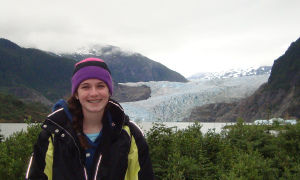Seeing the Effects of Global Warming
In our world today, climate change is a common topic, yet few people make an effort to change its effects. Global warming is defined as, “an increase in the earth’s atmospheric and oceanic temperatures widely predicted to occur due to an increase in the greenhouse effect resulting especially from pollution” (“Global Warming”). It is often depicted as only a minor concern, but the reality is that it can be life changing. The effects of climate change are currently becoming more visible in our environment each day.
In the summer of 2012, my family and I visited the breathtaking state of Alaska. It is famously known for its glaciers which are formed when more snow falls each winter than melts in summer, resulting in thick ice. While the scenery and animals were spectacular, the consequential actions of mankind were slowly becoming evident. Over the past fifty years, temperatures throughout Alaska increased by an average of 3.4°F. This caused more glaciers and snow to melt, resulting in rising water levels. Out of more than a hundred thousand glaciers in Alaska, ninety five percent are currently thinning, stagnating, or retreating. I was lucky enough to experience the glaciers of College Fjord and Glacier Bay. I remember one of the guides at Mendenhall Glacier explaining that it has been receding by an average rate of about 170 feet per year since 2005.
Countless people do not realize the negative effect of melting glaciers on the environment. Many locals are concerned because they rely on slow summer melt to fill their fresh water drinking supply. If it melts too fast, it will run to the sea and raise the ocean water levels. The earth’s warming creates early spring in Alaska, changing the ecosystem for the plants and animals. One example is the Alaskan salmon that lay eggs in freshwater pools; heavy melting causes faster river flow that can wash the eggs to the sea. This also increases the sea level, which may flood freshwater pools with salt water and further decreases the number of salmon. This directly impacts the population of predators that rely on them as a food source, such as the Alaskan Brown Bears and Bald Eagles.
Further north, global warming has decreased the size of the Arctic Ice Cap, along with the animals living there. Polar bears are now starving and underweight because the shrinking ice leaves less hunting ground and less time to hunt. By 2050, two thirds of the world’s polar bear population may be gone forever. Walruses, which spend almost all their lives on the ice or in the sea, are affected by the decreasing polar cap. They are now coming to the Alaskan shore by the thousands, something which has never happened before.
Further south, climate change has increased the water temperature of the Great Lakes. This causes more evaporation and drastic water-air temperature differences that causes “extreme lake effect snow” during intense cold air outbreaks. This effect just caused over six feet of snow in Buffalo, New York in one storm!
Scientists say global warming and its everlasting effects will remain an issue as long as the heat-trapping carbon dioxide in the atmosphere increases. The warming of the earth is mostly caused by the greenhouse effect. When the earth cools down, it gives off a form of energy called infrared radiation. Before all this radiation can escape to outer space, greenhouse gases in the atmosphere absorb some of it, which makes the atmosphere warmer. To prevent the warming, it is important to try to reduce the amount of waste produced, and increase recycling to lessen the amount of CO2 added to our atmosphere. We only have one world, so it is important for us, the inhabitants, to care properly for it and preserve it for many years to come. We are the future, and it is our responsibility to make a positive change for the world.
Works Cited:
“Global Warming.” Merriam-Webster.com. Merriam-Webster, n.d. Web. 30 Nov. 2014.








